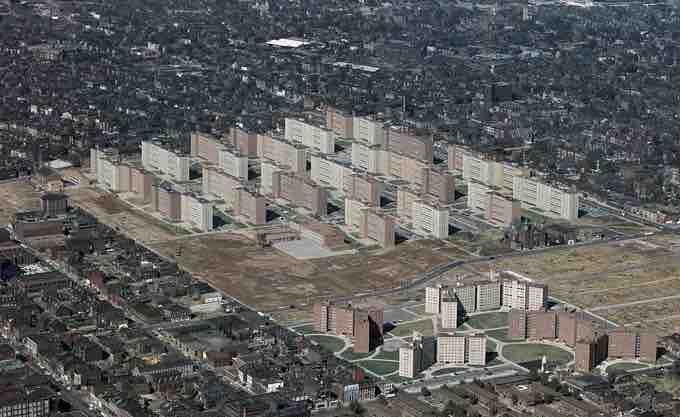Urban decline is the process whereby a previously functioning city or neighborhood falls into disrepair and decrepitude. Features of urban decline include deindustrialization, depopulation, economic restructuring, abandoned buildings, high unemployment, fragmented families, political disenfranchisement, crime, and a desolate landscape. Since the 1970s and 1980s, urban decline has been associated with Western cities having experienced institutional restructuring. In many countries outside of the West, urban decline manifests as peripheral slums at the outskirts of cities. In contrast, in North American and British cities, the impoverished areas begin to develop in the city center as individuals relocate their residences to suburban areas outside of the city. This process is frequently called white flight, in reference to the fact that the central urban areas usually remain inhabited by minority populations when white populations leave. Another characteristic of urban decay is blight, the visual, psychological, and physical effects of living daily life among empty lots, abandoned buildings, and condemned houses. Such desolate properties are socially dangerous to the community because they attract criminals and gangs, increasing the volume of crime.
Causes
But what causes urban decay? Though scholars can identify factors that contribute to urban decline, it is notoriously difficult to explain precisely why one urban area slips into decline and another with similar circumstances does not. That being said, urban decline results from some combination of socioeconomic decisions, such as the city's urban planning decisions, the poverty of the local populace, the construction of urban infrastructure (such as freeways, roads, and other elements of transportation), and the depopulation of peripheral lands by suburbanization.
Historic Causes
In some ways, urban decline is an inevitable result of urbanity itself. Cities tend to grow because of momentary economic booms. These economic successes can either evolve and sustain themselves, or contract. Economic decline tends to lead to urban decline. Given that economic fluctuations have such profound effects on urban development, it makes sense that issues associated with the modern iteration of urban decline began during the Industrial Revolution, the time period in the late eighteenth and early nineteenth century when rural people flocked to cities for employment in manufacturing. Overpopulation in very small spatial areas became a serious issue. While the individuals who worked in manufacturing positions frequently worked and lived in extremely poor conditions, the owners of the mills became rich quickly, bringing a striking influx of economic growth suddenly to cities. However, subsequent economic changes left many newly-grown cities economically vulnerable and marred with employment factors that contribute to urban decline.
Changes in means of transport, from public to private—or specifically from public trains to private motor cars—eliminated some advantages of living and working in the city and enabled suburbanization. Following World War II, political decisions in the U.S. further solidified the already growing trend of suburbanization. Many cities used city taxes to build new infrastructure in remote, racially-restricted suburban towns. Historically in the U.S., the white middle class gradually left the cities for suburban areas because of the perceived higher crime rates and dangers caused by African-American migration to northern cities after World War I; this demonstrates so-called white flight. This trend became more permanent with the construction of the Interstate Highway System under President Dwight D. Eisenhower in the 1960s.
Recent Causes
Deindustrialization, or the process of social and economic change caused by the removal or reduction of industrial capacity in a region that is known for its manufacturing industry, is one of the main recent causes for urban decline in the United States. Deindustrialization is a main culprit in creating the economic conditions that contribute to urban decline by pushing jobs outside of the main urban area. An example of deindustrialization and urban decline in the United States is Detroit. After free-trade agreements were instituted with less developed nations in the 1980s and 1990s, Detroit-based auto manufacturers relocated their production facilities to other areas where wages and working standards (and therefore costs of operation) were lower. Detroit and other industrial towns, such as Cleveland, Pittsburgh, and St. Louis, were once centers of production and associated with high standards of living. Today, they are associated with a high concentration of poverty, unemployment, abandoned buildings and noticeable isolation.
Response
The current response to urban decay has been positive public policy and urban design using the principles of New Urbanism. New Urbanism is an urban design movement that promotes walkable neighborhoods that contain a range of housing and professional options. The movement came about in the U.S. in the 1980s and continues to have impact on urban planning .

Pruitt-Igoe Housing Development Decay
The Pruitt-Igoe housing projects in St. Louis were built under a policy of urban renewal intended to provide affordable housing, but soon turned into a site of urban blight. They have since been demolished and the land is being redeveloped under a policy of New Urbanism.